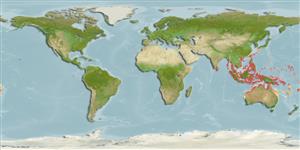Teleostei (teleosts) >
Beloniformes (Needle fishes) >
Hemiramphidae (Halfbeaks)
Etymology: Hemiramphus: Greek, hemi = half + Greek, rhamphos = bill, peak (Ref. 45335).
More on authors: Weber & deBeaufort.
Issue
Issue on validity of subspecies: the subspecies Hemiramphus convexus bruuni is elevated at species rank as Hemiramphus bruuni (Parin, Collette & Shcherbachev, 1980) in Eschmeyer (CofF ver. May 2011: Ref. 86870). The species page will be created.
Environment: milieu / climate zone / depth range / distribution range
Ecology
Marine; pelagic-neritic; depth range 0 - 6 m (Ref. 86942). Tropical
Indo-West Pacific: widespread in warmer waters from East Africa to Caroline Islands, New Guinea, New Britain and New Ireland. Replaced in the Red Sea, Arabian Sea and coastal waters in between by Oxyporhamphus convexus bruuni (Ref. 9843).
Length at first maturity / Size / Weight / Age
Maturity: Lm ?, range 14 - ? cm
Max length : 23.0 cm TL male/unsexed; (Ref. 10943); 17.6 cm SL (female)
More coastal than O. m. micropterus and frequently found near islands.
Life cycle and mating behavior
Maturity | Reproduction | Spawning | Eggs | Fecundity | Larvae
Collette, B.B. and J. Su, 1986. The halfbeaks (Pisces, Beloniformes, Hemiramphidae) of the Far East. Proc. Acad. Nat. Sci. Philadelphia 138(1):250-301. (Ref. 10943)
IUCN Red List Status (Ref. 130435)
Threat to humans
Harmless
Human uses
Fisheries: minor commercial
More information
ReferencesAquacultureAquaculture profileStrainsGeneticsElectrophoresesHeritabilityDiseasesProcessingNutrientsMass conversion
Tools
Special reports
Download XML
Internet sources
Estimates based on models
Preferred temperature (Ref.
123201): 25.3 - 29.3, mean 28.7 °C (based on 2285 cells).
Phylogenetic diversity index (Ref.
82804): PD
50 = 0.5005 [Uniqueness, from 0.5 = low to 2.0 = high].
Bayesian length-weight: a=0.00437 (0.00193 - 0.00988), b=3.08 (2.90 - 3.26), in cm total length, based on LWR estimates for this Genus-body shape (Ref.
93245).
Trophic level (Ref.
69278): 3.3 ±0.5 se; based on size and trophs of closest relatives
Generation time: 0.9 ( na - na) years. Estimated as median ln(3)/K based on 1
growth studies.
Resilience (Ref.
120179): High, minimum population doubling time less than 15 months (K>1).
Fishing Vulnerability (Ref.
59153): Low vulnerability (13 of 100).
